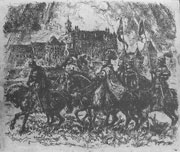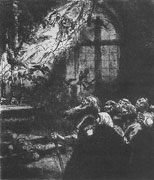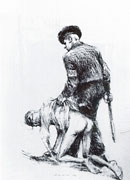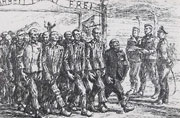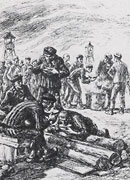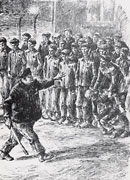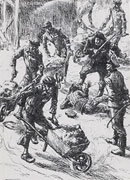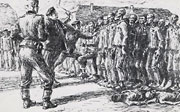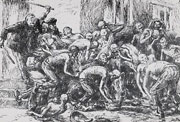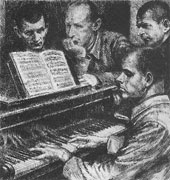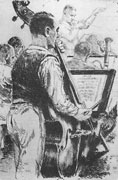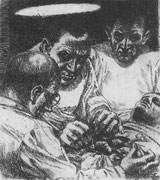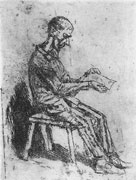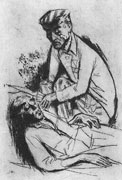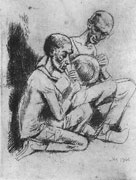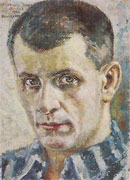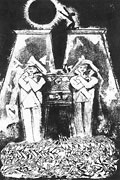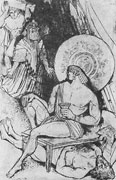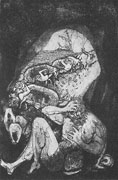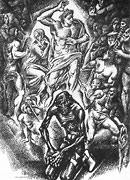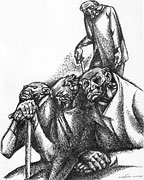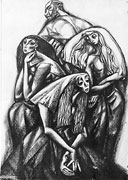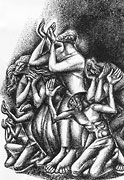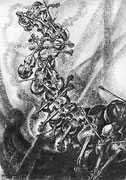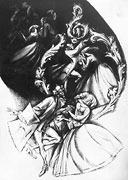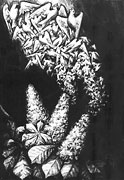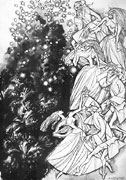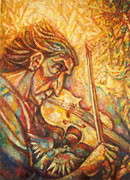
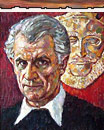

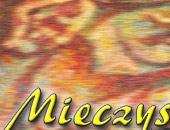

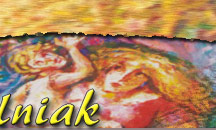






Creation
Achievements
Awards
Exhibitions
Contact
Creation
1950s
Achivements of Mieczyslaw Koscielniak which were presented during the individual and group exhibitions and the critics of art opinions.
Awards and Honours:
Jolanta Kupiec, a very experienced worker of the Museum in Oswiecim in the book titled äWhat remains after us...?ö, expresses her opinion about Koscielniak's concentration creation in following words:
Mieczyslaw Koscielniak, who left his mark in diverse fields of fine arts - painting, drawing and graphics and who was the prisoner of KL Auschwitz, created the richest plastic document about cruel terror and holocaust during the Second World War and in the first place in Germany concentration camps ... Large emotional charge and message in many works created in the concentration camp and after the war by Mieczyslaw Koscielniak allowed to reconstruct visions of many places and many dramatic events connected with functioning of KL Auschwitz and other concentration camps. Great technical mastry, both painting and outlines, their realism deeply shocked every receiver. His artistic works were very important documents because every generation - before war and after war - could understand their message. They not only remind us about cruelties of war but also warn humankind against degenerations threatening people overtaken by political, religious, racial fanaticism. His works showed aggression, violence, individual tragedies caused by national conflicts and wars. The most important is the fact that these works were visions created by the eyewitness, by the man who was in the concentration camp and learnt to understand suffering of every society in any concentration camp, independently of national and social differences. In spite of thematic diversity of works, Mieczyslaw Koscielniak illustrated issues connected with history of KL Auschwitz - Birkenau, life and martyrdom of prisoners, his works are a very rich didactic material, specially for history lessons on Auschwitz.
1960s
Achievements of the artist Mieczyslw Koscielanik presented during individual and group exhibitions and critics of art opinions.
Group exhibitions:
Boleslaw Prus' äPharaohö was the source of a creative stimulus for Mieczyslaw Koscielniak. Graphics in this series contained personal, orginal view of the author - in spite of his being inspired by the book. The series' main characterisitics was authentic feeling. The contact with ancient Egyptian culture, its might and power, was clearly visible.
The cycle was a symbiosis of the author's creative imagination and impression from journey to Egipt. Graphics of Mieczyslaw Koscielniak illustrating epic of Homer are characterised by clear composition and determined clear drawing. Logical connection of composition existed there. Drama is amplified by this composition as well as by strength of contrast between black and white colours and their location on the surface - in contrast to scenes of silent atmosphere, where composition was quiet without strong contrast of black and white but with gentle transition of grey. Introduction of architecture, clothes and accessories which strongly defined - but did not have the most essential role - placed his works in defined time and in defined geographic terms.
Bo┐ena Kowalska in the album promoting exhibition said:
„Illustrations for books are main stream of Koscielniakłs creative activity (à)
Koscielniak has illustrated 250 books so far, not mentioning albums containing reproductions of his drawings (à) The most significant works in Koscielniakłs output as a book illustrator are those made using metal techniques, for example aqua forts and dry needle.
(à) To leave the space for the viewersł to use own imagination or not to impose any personal vision, the artist uses a trick of making his work less realistic. The scenes, despite being always figurative, do not have features of reality; the author does not specify the objects, rejects the perspective, usually leaving the background blurred.
The creatures seen in the scenes created by Koscielniak do not have individual features. They are symbols. They stand for heroism, power, mourning, humility or slenderness and charm of femininity. They are not connected with action or situation, but with logic and laws of the composition. The artist constructs the scenes bearing strong emotional tension such as fight, struggle and revenge, on the basis of diagonal axis, those idealistic - on the basis of axis of balanced rectangles or ovals. Dependently on the mood, the artist puts white, black and grey in balance or dramatically contrasts them. Thanks to using sign and antirealism of the visions with simultaneous subordinating them to the laws of composition logic, Koscielniakłs illustrations do not restrain the viewersł imagination, on the contrary - they enrich it. In the same time, in spite of the fact that the illustrations are of historic contain, they keep up with modern artistic conceptions. „This kind of illustration is less frequently met nowadays, it is more rare also because the fact that the size of works is usually bigger than 0.5 meter. Due to their size, they gain features of portfolio graphics and they are edited in Poland in a form of loose prints connected by a common topic", says Bo┐ena Kowalska.
1970s
Achievements of Mieczyslaw Koscielniak presented during individual and group exhibitions, and critics opinions.
Medals, rewards and awards:
„The artist kept on warning against what had happened during the Second World War and against what could happen again. The expression of it are series „The man - Pessimistic Impressionsö which are to sum up experiences and diligent years. The power and misery of a human being are presented here. Of the human being which is powerless against laws of the world, against evil caused by other people.ö Jolanta Kupiec writes in her book „What remains after usà?
Judyta Dymkowska in Wojciech Brodnickiłs article, printed in „Kurier Polskiö said about „The Pessimistic Impressionsö: „It is to sum up experiences and diligent years. The artist tends to express the problems of the biggest importance, exceeding time limits, which refer to all the people. The power and misery of a human being are presented here. Of the human being which is powerless against laws of the world, against evil caused by other people. Everlasting, always up to date matters of human existence. What a suggestive artistic vision - and it makes one think about de Bruynełs words „in the place in which abstract knowledge would change us into an icicle, only artistic intuition allows us to remain humans of vivid sensitivity and hot heart.ö
In the same article the artist says:
„łThe Pessimistic Impressionsł contain the question: what is the world, what are our Earth and a man? Why do we exist, why do we argue, why do we suffer constantly? Is it really like the philosophers and religions say or maybe is it different? That insecurity, being out of balance happens quite often to me. But I gain balance back, because I believe in the ultimate justice, my pessimism is based on a thought that through suffering of a being or a nation, happiness and understanding of sense of life can be reached.ö
Koscielniak was fascinated by music, which inspired him to create many paintings, graphics and series devoted to the greatest composers. „Music is one of the most abstract fine arts,ö he said,ö Works of the greatest: Beethoven, Mozart, Chopin, Bach bring inspiration and solace, harmony and peace to me. For me, art is like a palette where are either colours or musical tones, or entire abundance of words, I never work without music.ö
„Can the sound be painted? No, it is impossible. Yet (à) Vibrating, crystal structure of the background, surrounding the violin player with colourful light makes me see the sounds, I feel music, I hear it with my sight (à)ö, said W. Wajnert about „The violin concertö.
„ Transient, elongated or vibrating or crystalline structures of composition allow to „hear” all tones and semitones, their escalation and muffling, „says Jolanta Kupiec about paintings of musical theme in her book „What remains after usà?”
W folderze wydanym przy okazji Wystawy Indywidualnej w roku 1975 w Radomiu , komisarz wystawy Ewelina Pietrzy±ska napisala :
„The series of Koscielniakłs aqua forts devoted to immortal „Iliad” or „Odyssey” can be easily considered as an unusual event. But not only the fact that such works do exist makes us to consider them as one of the most interesting events. I think that matter of form is interesting in this case too as well as matter of interpretation of text. The illustrations of Homerłs works are really rare in Poland, but among them there are those of Stanislaw Wyspia±ski. Undoubtedly, the critics and audience will take the chance of confronting their comparisons. Then individual way of Koscielniak, who did not look for inspiration in immature classical forms, but who sought inspiration in expressive shapes of Greek archaism, will be clearly seen(à) Koscielniak still remained a realist,” says Ewelina Pietrzy±ska, the commissioner of Koscielniakłs individual exhibition in Radom in 1975.
„We should not look for any excessive historical matters in the works of Koscielniak. He did not enter in, suggestive in such cases, matter of archeology. On the contrary, he showed his modern outlook both to question of content and artistic form (à) Koscielniak remained a realist, he derived everything from the link with nature, but maturity brought to him conviction and consciousness that the bottom line is the artistic transformation of reality. In that matter, his effort is worth of attention,” says Ignacy Witz, a highly valued critic.
The exhibition which took place in 1978 in The Community Centre of K.I. Galczy±ski was judged by W.Wajnert in a folder edited for this exhibition with these words:
„The works of Mieczyslaw Koscielniak are known to the broad audience thanks to numerous exhibitions in the country and abroad, and they confirm not only his great talent, but also his unique creative innovation.
However, right now this artist of huge creative powers surprises us with the newest, piercing series. Up to now his works have been inspired either by literature or by his own personal experience. In presently presented series, Mieczyslaw Koscielniak reaches further, presenting human matters in timeless context against the background of philosophic thoughts.
How rich is his creative technique and how big is the amount of his means of expression! The drama of his works is multiplied by the idea, the composition full of expression as well as by the strength of the contrasts between black and white. From it the artist shifts towards surprising calming of the atmosphere obtained by the masterly used halftones, leading to romantic mood. I wonder how he is able to make black and white graphics so colourful and picturesque, not to make creation of the figures unreal and alienated, and how it is possible that so frequent deformation do not antagonise, but instead enrich the content by adding expression means. Yet it remains the secret of his art. It is not possible to describe this way of painting. It is impossible - despite simple expression means used - to put it any known scheme. Watching it passively also will not be satisfying. So it worth attempting to perceive Mieczyslaw Koscielniakłs art actively, in accordance with Bhaskarałs words ęLook and thinkł.”
Achivements of Mieczyslaw Koscielniak which were presented during the individual and group exhibitions and the critics of art opinions.
Awards and Honours:
- 1951 - Honour - Warsaw - I Polish Exhibition of Poster, Illustration and Small forms.
- 1951 - Honour for illustrations to äKonrad Wallenrodö - Warsaw, Polish Exhibition of Book Illustration
- 1955 - The Golden Medal of Merit for artistic work during staying in concentration camp in 1940-1945
- 1955 - The Medal to commemorate tenth anniversary People's Republic of Poland
- 1956 - prize winner of 3rd award in competition in the illustrations to writings A. Mickiewicz
- 1950, 1951, 1954 - Warsaw - I, II, IV Polish Exhibition of Fine Arts
- 1951 - Warsaw - I Polish Exhibition of Poster, Illustration and Small Forms - award
- 1952 - Venice - Art Biennale
- 1953 - Belgium, Holland
- 1953 - 1964 - Warsaw, Stockholm, Beijng, Venice, Moscow, Chicago
- 1954 - Finnland
- 1954/55, 1957 - The Soviet Union
- 1955 - Warsaw - II Polish Exhibition of Poster, Illustration and Small Forms
- 1956, 1959 - Warsaw - I, II Exhibition of Artistic Graphics
- 1959 - Warsaw, individual exhibition of graphics - The Gallery of the Modern Art äNew Worldö
Jolanta Kupiec, a very experienced worker of the Museum in Oswiecim in the book titled äWhat remains after us...?ö, expresses her opinion about Koscielniak's concentration creation in following words:
Mieczyslaw Koscielniak, who left his mark in diverse fields of fine arts - painting, drawing and graphics and who was the prisoner of KL Auschwitz, created the richest plastic document about cruel terror and holocaust during the Second World War and in the first place in Germany concentration camps ... Large emotional charge and message in many works created in the concentration camp and after the war by Mieczyslaw Koscielniak allowed to reconstruct visions of many places and many dramatic events connected with functioning of KL Auschwitz and other concentration camps. Great technical mastry, both painting and outlines, their realism deeply shocked every receiver. His artistic works were very important documents because every generation - before war and after war - could understand their message. They not only remind us about cruelties of war but also warn humankind against degenerations threatening people overtaken by political, religious, racial fanaticism. His works showed aggression, violence, individual tragedies caused by national conflicts and wars. The most important is the fact that these works were visions created by the eyewitness, by the man who was in the concentration camp and learnt to understand suffering of every society in any concentration camp, independently of national and social differences. In spite of thematic diversity of works, Mieczyslaw Koscielniak illustrated issues connected with history of KL Auschwitz - Birkenau, life and martyrdom of prisoners, his works are a very rich didactic material, specially for history lessons on Auschwitz.
1960s
Achievements of the artist Mieczyslw Koscielanik presented during individual and group exhibitions and critics of art opinions.
Group exhibitions:
- 1961 - Warsaw - Exhibition of Artistic Graphics
- 1961 - Warsaw - Exhibition of Book and Illustration
- 1963 - Canada
- 1964 - The Republic of West Germany, Sweden
- 1965 - The Republic of East Germany
- 1965 - Austria, China, Romania
- 1966 - Rzeszow
- 1967 - Warsaw - Polish Exhibition of Book Graphics
- 1961 - Warsaw - The Guardhouse
- 1962, 1965 - Slupsk
- 1963 - lod╝
- 1963, 1968, 1969 - Warsaw
- 1964 - The Republic Of India
- 1964 - Radom
- 1964 - Kielce
- 1965 - Koszalin
- 1965 - Kolobrzeg
- 1965 - Bydgoszcz
- 1965 - Elblag
- 1965, 1969, 1975, - Kalisz
- 1968 - Toru±
- 1969 - Turek
- 1969.06.12 - Warsaw - The Guardhouse
Boleslaw Prus' äPharaohö was the source of a creative stimulus for Mieczyslaw Koscielniak. Graphics in this series contained personal, orginal view of the author - in spite of his being inspired by the book. The series' main characterisitics was authentic feeling. The contact with ancient Egyptian culture, its might and power, was clearly visible.
The cycle was a symbiosis of the author's creative imagination and impression from journey to Egipt. Graphics of Mieczyslaw Koscielniak illustrating epic of Homer are characterised by clear composition and determined clear drawing. Logical connection of composition existed there. Drama is amplified by this composition as well as by strength of contrast between black and white colours and their location on the surface - in contrast to scenes of silent atmosphere, where composition was quiet without strong contrast of black and white but with gentle transition of grey. Introduction of architecture, clothes and accessories which strongly defined - but did not have the most essential role - placed his works in defined time and in defined geographic terms.
Bo┐ena Kowalska in the album promoting exhibition said:
„Illustrations for books are main stream of Koscielniakłs creative activity (à)
Koscielniak has illustrated 250 books so far, not mentioning albums containing reproductions of his drawings (à) The most significant works in Koscielniakłs output as a book illustrator are those made using metal techniques, for example aqua forts and dry needle.
(à) To leave the space for the viewersł to use own imagination or not to impose any personal vision, the artist uses a trick of making his work less realistic. The scenes, despite being always figurative, do not have features of reality; the author does not specify the objects, rejects the perspective, usually leaving the background blurred.
The creatures seen in the scenes created by Koscielniak do not have individual features. They are symbols. They stand for heroism, power, mourning, humility or slenderness and charm of femininity. They are not connected with action or situation, but with logic and laws of the composition. The artist constructs the scenes bearing strong emotional tension such as fight, struggle and revenge, on the basis of diagonal axis, those idealistic - on the basis of axis of balanced rectangles or ovals. Dependently on the mood, the artist puts white, black and grey in balance or dramatically contrasts them. Thanks to using sign and antirealism of the visions with simultaneous subordinating them to the laws of composition logic, Koscielniakłs illustrations do not restrain the viewersł imagination, on the contrary - they enrich it. In the same time, in spite of the fact that the illustrations are of historic contain, they keep up with modern artistic conceptions. „This kind of illustration is less frequently met nowadays, it is more rare also because the fact that the size of works is usually bigger than 0.5 meter. Due to their size, they gain features of portfolio graphics and they are edited in Poland in a form of loose prints connected by a common topic", says Bo┐ena Kowalska.
1970s
Achievements of Mieczyslaw Koscielniak presented during individual and group exhibitions, and critics opinions.
Medals, rewards and awards:
- 1971 - The Golden Plate - for recording his recollection of Maksymilian Kolbełs martyrdom.
- 1975 - The Medal of The Commission of National Education
- 1971 - Rome
- 1976 - Warsaw - The Club of The International Press and Book, „I wonłt die allö
- 1973 - Sztutow - The Stutthof Museum, „The Stations of Lifeö
- 1974 - Kielce
- 1975 - Kalisz
- 1975.02 - Radom
- 1979r. 05/06 - Warsaw - The Community Centre of K.I.Galczy±ski
„The artist kept on warning against what had happened during the Second World War and against what could happen again. The expression of it are series „The man - Pessimistic Impressionsö which are to sum up experiences and diligent years. The power and misery of a human being are presented here. Of the human being which is powerless against laws of the world, against evil caused by other people.ö Jolanta Kupiec writes in her book „What remains after usà?
Judyta Dymkowska in Wojciech Brodnickiłs article, printed in „Kurier Polskiö said about „The Pessimistic Impressionsö: „It is to sum up experiences and diligent years. The artist tends to express the problems of the biggest importance, exceeding time limits, which refer to all the people. The power and misery of a human being are presented here. Of the human being which is powerless against laws of the world, against evil caused by other people. Everlasting, always up to date matters of human existence. What a suggestive artistic vision - and it makes one think about de Bruynełs words „in the place in which abstract knowledge would change us into an icicle, only artistic intuition allows us to remain humans of vivid sensitivity and hot heart.ö
In the same article the artist says:
„łThe Pessimistic Impressionsł contain the question: what is the world, what are our Earth and a man? Why do we exist, why do we argue, why do we suffer constantly? Is it really like the philosophers and religions say or maybe is it different? That insecurity, being out of balance happens quite often to me. But I gain balance back, because I believe in the ultimate justice, my pessimism is based on a thought that through suffering of a being or a nation, happiness and understanding of sense of life can be reached.ö
Koscielniak was fascinated by music, which inspired him to create many paintings, graphics and series devoted to the greatest composers. „Music is one of the most abstract fine arts,ö he said,ö Works of the greatest: Beethoven, Mozart, Chopin, Bach bring inspiration and solace, harmony and peace to me. For me, art is like a palette where are either colours or musical tones, or entire abundance of words, I never work without music.ö
„Can the sound be painted? No, it is impossible. Yet (à) Vibrating, crystal structure of the background, surrounding the violin player with colourful light makes me see the sounds, I feel music, I hear it with my sight (à)ö, said W. Wajnert about „The violin concertö.
„ Transient, elongated or vibrating or crystalline structures of composition allow to „hear” all tones and semitones, their escalation and muffling, „says Jolanta Kupiec about paintings of musical theme in her book „What remains after usà?”
W folderze wydanym przy okazji Wystawy Indywidualnej w roku 1975 w Radomiu , komisarz wystawy Ewelina Pietrzy±ska napisala :
„The series of Koscielniakłs aqua forts devoted to immortal „Iliad” or „Odyssey” can be easily considered as an unusual event. But not only the fact that such works do exist makes us to consider them as one of the most interesting events. I think that matter of form is interesting in this case too as well as matter of interpretation of text. The illustrations of Homerłs works are really rare in Poland, but among them there are those of Stanislaw Wyspia±ski. Undoubtedly, the critics and audience will take the chance of confronting their comparisons. Then individual way of Koscielniak, who did not look for inspiration in immature classical forms, but who sought inspiration in expressive shapes of Greek archaism, will be clearly seen(à) Koscielniak still remained a realist,” says Ewelina Pietrzy±ska, the commissioner of Koscielniakłs individual exhibition in Radom in 1975.
„We should not look for any excessive historical matters in the works of Koscielniak. He did not enter in, suggestive in such cases, matter of archeology. On the contrary, he showed his modern outlook both to question of content and artistic form (à) Koscielniak remained a realist, he derived everything from the link with nature, but maturity brought to him conviction and consciousness that the bottom line is the artistic transformation of reality. In that matter, his effort is worth of attention,” says Ignacy Witz, a highly valued critic.
The exhibition which took place in 1978 in The Community Centre of K.I. Galczy±ski was judged by W.Wajnert in a folder edited for this exhibition with these words:
„The works of Mieczyslaw Koscielniak are known to the broad audience thanks to numerous exhibitions in the country and abroad, and they confirm not only his great talent, but also his unique creative innovation.
However, right now this artist of huge creative powers surprises us with the newest, piercing series. Up to now his works have been inspired either by literature or by his own personal experience. In presently presented series, Mieczyslaw Koscielniak reaches further, presenting human matters in timeless context against the background of philosophic thoughts.
How rich is his creative technique and how big is the amount of his means of expression! The drama of his works is multiplied by the idea, the composition full of expression as well as by the strength of the contrasts between black and white. From it the artist shifts towards surprising calming of the atmosphere obtained by the masterly used halftones, leading to romantic mood. I wonder how he is able to make black and white graphics so colourful and picturesque, not to make creation of the figures unreal and alienated, and how it is possible that so frequent deformation do not antagonise, but instead enrich the content by adding expression means. Yet it remains the secret of his art. It is not possible to describe this way of painting. It is impossible - despite simple expression means used - to put it any known scheme. Watching it passively also will not be satisfying. So it worth attempting to perceive Mieczyslaw Koscielniakłs art actively, in accordance with Bhaskarałs words ęLook and thinkł.”


